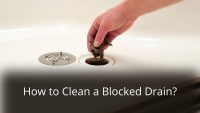7 Common Causes of clogged drains in the home
The first common cause of clogged drains in the home is grease. A grease is a liquid that becomes solid when it cools and will congeal on kitchen surfaces or gums up in the drain. Grease is usually found in kitchens and bathrooms, but it can also accumulate on kitchen appliances or bathroom fixtures. Here you will read the following causes:

Fruit Peels and Rinds
Fruit peels and rinds are common causes of clogged drains in the home. When these items are disposed of improperly, they can often find their way into the drain and cause it to back up. There are several ways to prevent this from happening, including properly disposing of fruit waste and using a garbage disposal unit.
Hair
Hair can get caught in the drain of your shower, bathroom sink, or kitchen sink. It may be just one strand or a lot of hair causing the clog. This type of issue is often caused by hair that has been seeping into the drain from a shower (shower drains) or bathtub.
Dirt
You can do a few things to avoid getting dirt on your clothes while washing them. Make sure to mud off and shake or rinse off the dirt outside the sink before bringing the clothes inside. Also, clear any debris from drain openings with grills or a plunger before showering.
Dirt, leaves, and plants are some of the most common causes of drain blockages. When these items accumulate in drains, they can cause a backup and overflow. In order to avoid this, it is best to get rid of dirt elsewhere than your shower or bathtub.
Small objects
Objects other than water, human waste, and toilet paper or paper towel can clog the drain. To keep your drains from flooding, educate kids about the proper way to use the toilet and make sure objects or feminine products are disposed of properly. Buy sink drain covers for protection and bathtub drain covers for safety. Sometimes, tree roots have grown into the pipe below the ground.
Food waste
Food waste is becoming a more pressing issue as the world’s population grows and the demand for food increases. In addition, coffee grounds are a valuable resource that can be used to reduce food waste. Minor kitchen sink blockages can also be caused by food waste, so it’s important to take steps to prevent them.
Grease, fat, and oil
When you’re finished cooking, do not put large chunks of food down the drain. This will cause your sink to clog and overflow. Instead, scrape leftovers into a garbage can. Pour leftover cooking oils and fats into a melt-proof container, then wipe clean the area around the sink.
The best way to avoid clogged drains is to prevent them from happening in the first place by keeping your garbage disposal clean and free of large chunks of food. Use a garbage disposal cleaner once a month to keep the blades sharp and clear of debris.
Soap
Soap residue, known as soap scum, can accumulate over time and cause drainage issues in laundry, shower, and bathroom drains. The traditional soap bars are ladened with grease or fat which can accumulate on the pipes over time and cause them to clog. Additionally, the sum of the soap residue and grease can stain the clogged pipe and bath fittings, leading to even more drainage problems or slow water drainage issues.
What to do when you have a clogged drain
There are a few things you can do when you have a clogged drain. You can try using a plunger, a snake, or a chemical drain cleaning expert. If those don’t work, you can call a plumber to help you fix the problem.
If you have a single toilet, sink, shower, or bathtub that is backed up and not draining properly, try these simple methods:
* use a plunger
* call a drain professional plumber
If there are multiple fixtures that are backing up and not draining properly, then you may need to call in professional help.
We can replace damaged or broken pipes or drain pipes with alternative methods like a composite resin lining, or standard repairs that require digging everything up.
Common causes of blocked sinks, baths, and showers
There are a variety of things that can cause your drains to become clogged. Some of the most common causes are hair, small objects, toilet paper, and cooking oil or fat deposits. It is important to be aware of these potential blockages so that you can take steps to prevent them from happening.
In addition, there are several common causes of blocked sinks, baths, and showers:
– Debris: This can include anything from hair to food particles.
– Soap-suds: When too much soap builds up, it can cause a blockage.
– Blockages in pipes: If there is a blockage in one of the pipes leading to your sink, bath or shower, it can cause the water to back up.
There are a variety of reasons why sinks, baths, and showers can become clogged. The most common causes are:
– Hair: When hair accumulates in the drainage system, it can form a blockage.
– Soap scum: Soap scum is a build-up of detergent that can accumulate over time and cause a blockage.
– Food waste: Food waste can decompose and create a blockage.
– Miscellaneous objects: If something falls down the drain, it can create a blockage.
To unblock a sink, bath, or shower:
– Use a plunger to dislodge the obstruction.
– Pour boiling water over the obstruction to loosen it up.
How to unblock a sink, bath, or shower
If you have a plunger, place it over the drain and pump to dislodge the obstruction. If this doesn’t work, pour boiling water down the sink or shower drain. This will loosen the obstruction and will make it easier to get rid of.
If you have a drain snake, use this to dislodge the obstruction or loosen it up. You can also try using a chemical drain cleaner to break down the obstruction.
If you can’t get rid of the clog, call a plumber because there is a plumbing problem.
How to Clean a Blocked Drain?
There are a few things you can do to clean a blocked drain in your household. The first is to try to clear the blockage with a plunger. If that doesn’t work, use a hair strainer drain guard to prevent hair from going down the drain and clean it regularly. You can also keep the drain openings clean and tidy and make sure they are covered with effective grills.

To clean a blocked drain, use a plunger. Pour water into the drain and then place the plunger over the top of the pipe. Push and pull the plunger until all of the water has been pushed through the drain. If this does not work, try using a snake to clear out any clogged pipes.
In addition, there are a few methods that can be used to clean a blocked drain. One of the most popular methods is to use a plunger. Pour water into the drain and place the plunger over the top of the pipe. Push and pull the plunger until all of the water has been pushed through the drain. If there is any debris in the drain, it can be cleaned with a brush or vacuum cleaner.




